Plan your Beijing Tour? Visiting Beijing offers a chance to explore some of China’s most iconic landmarks, and the Temple of Heaven is undoubtedly one of the must-see sights. This massive complex, a UNESCO World Heritage site, holds immense historical and cultural significance.
If you’re planning to visit Beijing, this ultimate guide will give you everything you need to know about how to visit the Temple of Heaven. From its rich history to practical tips, you’ll be fully prepared for your trip!
1. A Brief History of the Temple of Heaven
The Temple of Heaven, or Tiantan, was constructed in 1420 during the reign of Emperor Yongle, the same emperor who built the Forbidden City. The temple was used by emperors of the Ming and Qing dynasties as a sacred place to pray for good harvests. Every year, the emperor would make offerings and conduct rituals here, believing that the heavens would respond with prosperity.
Additionally, the architecture of the Temple of Heaven reflects deep symbolism. For instance, the circular design of the Hall of Prayer for Good Harvests symbolizes heaven, while the square base represents earth. This unique layout represents the ancient Chinese belief in the harmony between heaven and earth. With this background in mind, you’ll truly appreciate the significance of this cultural treasure.
2. Best Time to Visit the Temple of Heaven
The Best Seasons
Timing is everything when visiting popular tourist attractions. So, how to visit Temple of Heaven at the best time? Generally, the best time to visit is during the spring (April to June) and autumn (September to October). During these months, the weather is pleasant, and the gardens surrounding the temple are in full bloom or dressed in beautiful fall colors.
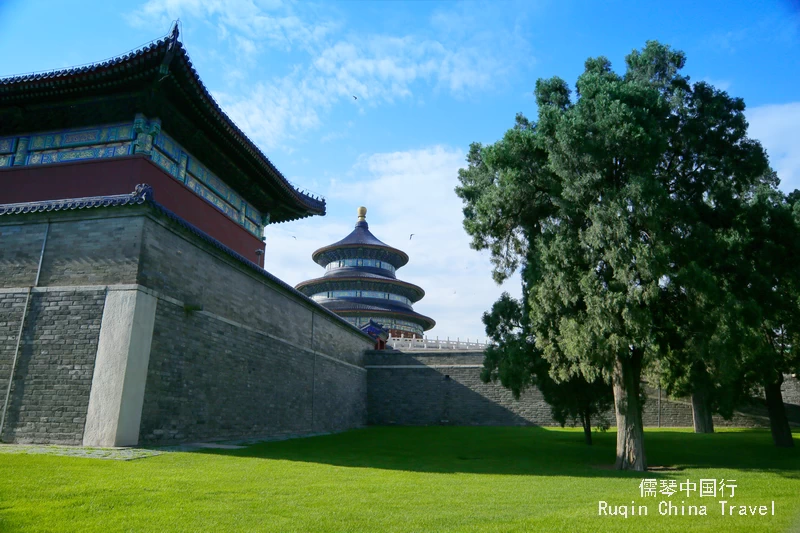
In winter, the Temple of Heaven sees fewer tourists, and although it’s colder, the peace and quiet might be worth it if you want to avoid the crowds. However, make sure to bundle up, as Beijing’s winters can be quite harsh.
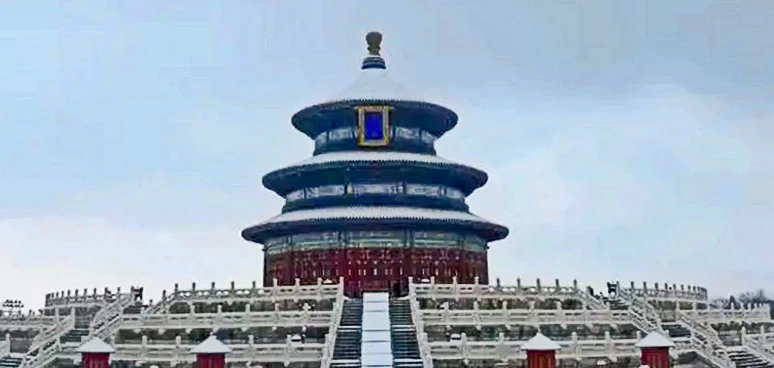
Best Time of the Day
Early Mornings
Early Mornings are ideal if you want to experience the park when it’s less crowded. Locals gather to practice tai chi, play traditional instruments, and engage in other morning activities.
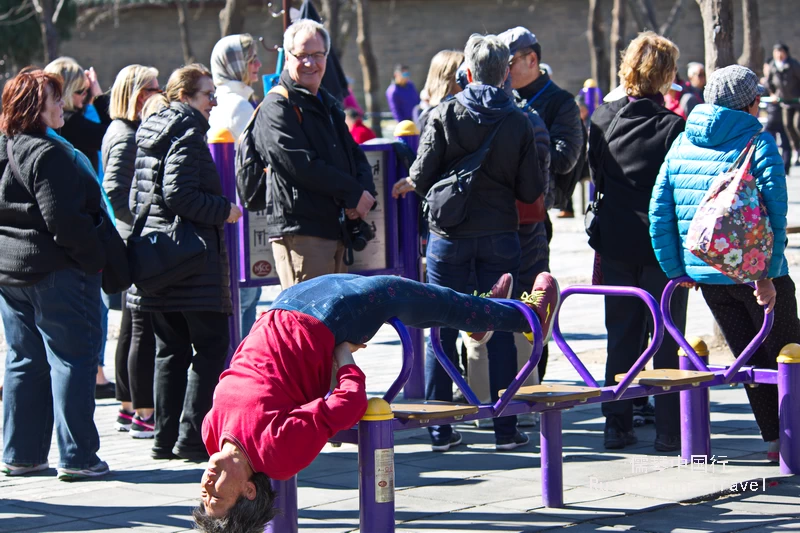
It’s a serene start to your day, allowing you to see Beijing’s local culture firsthand. On the other hand, late afternoons offer soft sunlight, making it perfect for photography.
At Dusk
At dusk, as the sun sets, the Temple of Heaven is bathed in a golden glow. The Hall of Prayer for Good Harvests is enveloped in warm sunlight, while the Imperial Vault of Heaven and the Circular Mound Altar are also bathed in the soft, ethereal hues of the sunset. Simply breathtaking.
At Night
At night, when the lights come on, the intricate details of the Hall of Prayer for Good Harvests become vividly clear, offering a completely different and breathtaking experience. Every Friday, Saturday, and on public holidays, the Temple of Heaven is illuminated in dazzling lights, beautifully complementing its ancient architecture.
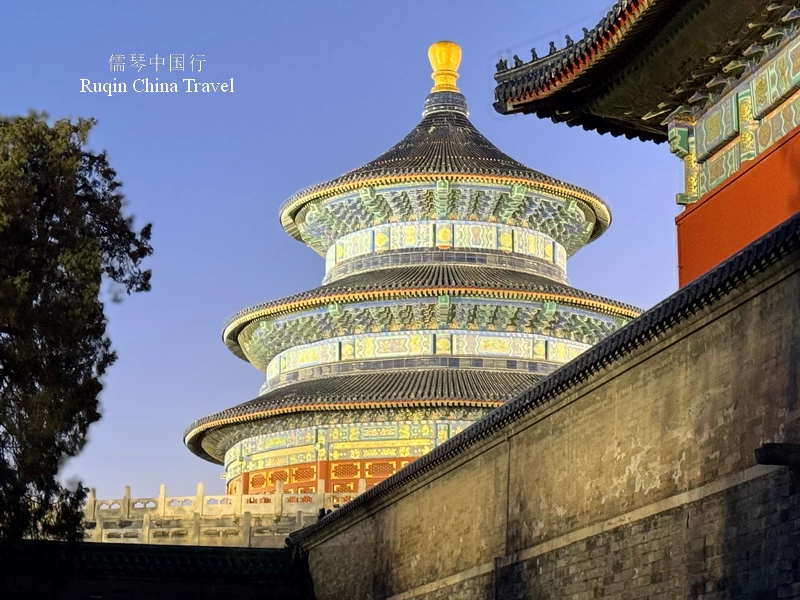
While the Hall itself is closed to visitors after dark, you can still admire its stunning beauty, bathed in the glow of the lights from the surrounding areas.
3. How to Get to the Temple of Heaven
To get to the Temple of Heaven in Beijing, you can use various transportation options depending on your starting point:
Subway: The most convenient way to reach the Temple of Heaven is by taking the subway. The nearest subway station is Temple of Heaven East Gate Station of Subway Line 5 ( 天坛东门站), with Exit A leading directly to the East Gate of the park.
Alternativley, you also can take Subway Line 8 and get off at the Station of Tianqiao (天桥站), exit at the Exit C, and walk about 350 m to reach the West Gate to the Temple of Heaven Park.
Bus: Many buses have routes that pass near the Temple of Heaven. You can check with your hotel or use the Beijing public transportation website to find the most suitable bus route based on your starting point. Bus stops near the Temple of Heaven include Tiantan East Gate, Tiantan South Gate, or Yongdingmen Gate. Suggested bus lines: Bus 36, 120, 122, 800, 803, 958
Taxi or Ride-hailing: Taxis and ride-hailing services like Didi are widely available in Beijing. You can simply provide the driver with the address or name of the Temple of Heaven (Tiantan) in Chinese (天坛) and they will take you to the nearest entrance.
Bike-sharing: Beijing has a bike-sharing system that allows you to rent bicycles for short-distance travel. Look for bike-sharing stations near your location and at the Temple of Heaven. You can unlock a bike using a mobile app and ride it to the temple. Just remember to park the bike in a designated area when you arrive.
Private Car: If you have access to a private car or are using a car rental service, you can drive to the Temple of Heaven. There are parking facilities available near the temple complex, but it’s important to check for parking availability and fees ahead of time.
It’s advisable to check the traffic conditions, especially during peak hours, and plan your journey accordingly. Additionally, be sure to have the name and address of the Temple of Heaven ( 天坛公园)written down in Chinese characters or on a map to show to taxi drivers or ask for directions if needed.
4. Temple of Heaven Entrance Fees
Purchase tickets at the box office. Be prepared to show identification, such as a passport. Entrance fees for the main temple park and the Hall of Prayer for Good Harvest are separate. It’s best to bring cash when buying tickets.
Park Admission Fee
15 yuan from April to November and 10 yuan from December to March.
Note: with this ticket, you can enter the park, watch the locals do morning exercises, and see the historic buildings outside the temple ( the Hall of Prayer for Good Harvest, the Zenith and Circular Mound Altar).
Temple Admission Fee (the Hall of Prayer for Good Harvest, the Zenith and Circular Mound Altar):
20 yuan
Through-ticket :34 yuan (April to November), 28 yuan (December to March).
Note: with the pass, you can enter the park and visit the three paid historical sites in the temple – the Hall of Prayer for Good Harvest, the Zenith and Circular Mound Altar.
Student Ticket: 50% discount
Senior Citizens (60 and above): Free
Children under 12: free
Note:
1) For first-time visitors, we highly recommend purchasing the through-ticket to save time and avoid the need for a second round of ticketing.
2)During peak tourist season, we recommend booking your tickets in advance via apps like WeChat or Alipay to save time.
Address: No. 1, Tiantan Dongli, Dongcheng District, Beijing
Phone: 010-67028866
5. Tour Guide Service at Temple of Heaven
Electronic Audio Guides:
- Availability: You can rent an audio guide at all park entrances, making it easy to start your self-guided tour as soon as you arrive.
- Hours: The audio guides are available from 8:15 AM to 6:00 PM, giving you plenty of time to explore.
- Languages: These guides come in a wide variety of languages, including Mandarin, English, French, Spanish, Russian, Japanese, Korean, German, Portuguese, Italian, Polish, Slovak, Indonesian, Vietnamese, Czech, Mongolian, Bulgarian, Arabic, and Thai.
- Fees:
- Mandarin (普通话): 30 RMB (No deposit required).
- Other Languages: 40 RMB (No deposit required).
Live Tour Guide Services:
- Location: You can find live tour guides at the South Gate of the Temple of Heaven park, where they are ready to provide an enriching experience.
- Hours: The live tour services are available from 8:00 AM to 3:00 PM, giving you flexibility to choose a time that fits your schedule.
- Languages: Live tours are offered in both Chinese and English, so you can choose the language that’s most convenient for you.
- Fees (charged per hour):
- For English tours, the cost is:
- 1-5 people: 300 RMB
- 6-10 people: 350 RMB
- 11-15 people: 400 RMB
- 16-20 people: 450 RMB
- For English tours, the cost is:
- Important Note: Group tours require advance booking at least 2 days ahead of your visit. To book a tour, contact the tour guide office directly at: 010-67025289.
6. Temple of Heaven Opening Hours
The Temple of Heaven Park is usually open from early morning until late afternoon. However, the opening hours may vary depending on the season and any specific events or closures. It’s best to check the official website or contact the temple in advance to confirm the opening hours for your visit.
High season : ( April 01- October 31)
Off season : ( November 01 to March 31 )
The Park Opening Hours
High season opening hours: 6:00-21:00
Off season opening hours: 6:30-21:00
Park is closed at 22:00
Opening Hours for the Historical Buildings inside the temple
(mainly the Imperial Vault of Heaven, the Circular Mound Altar, the Imperial Vault of Heaven)
High season opening time: 8:00-17:30 (Last Entry at 17:00)
Off season opening time: 8:00-17:00 (Last entry at 16:30)
For first-time visitors, we highly recommend purchasing the through-ticket to save time and avoid the need for a second round of ticketing.
7. Temple of Heaven Best Walking Route
The Temple of Heaven Park has four main entrances, and the best one to use is the East Gate. This entrance leads you straight into the heart of the park, and from here, a picturesque walking route will guide you through its main attractions.
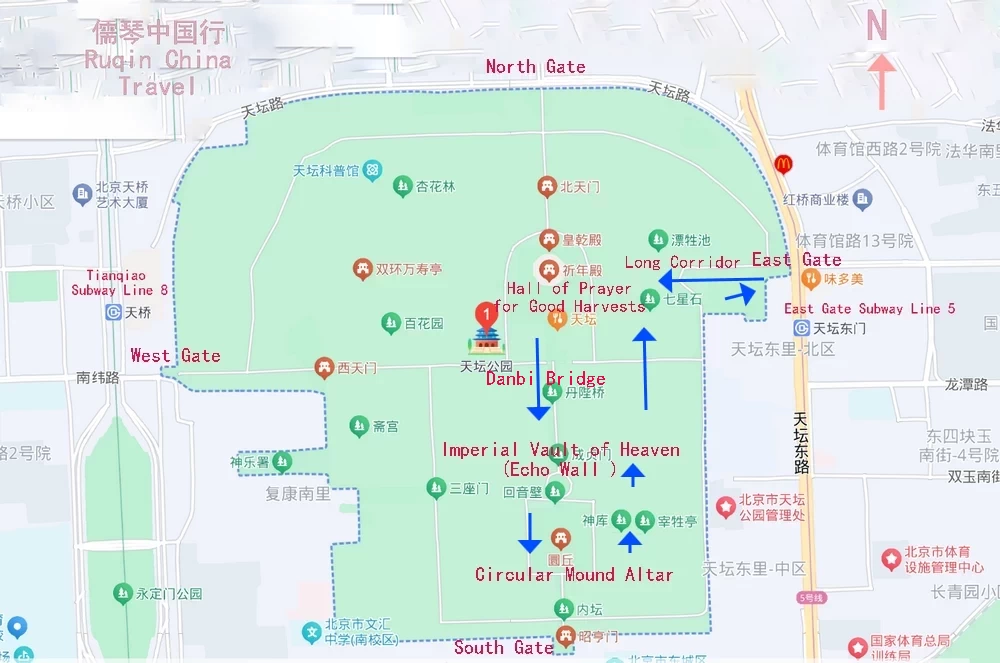
Upon entering, you’ll pass through the expansive Long Corridor, a scenic walkway that winds through the park.
1) Stroll through the Long Corridor
This beautifully crafted walkway stretches 350 meters, curving gently through the park. At 5 meters wide, it offers ample space for a leisurely walk. Its intricate decorations are not only visually stunning but also a testament to the artistry of ancient Chinese architecture.
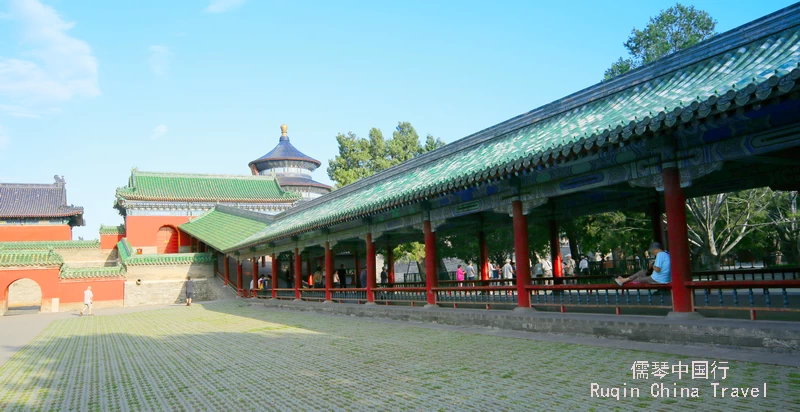
Walking through the Long Corridor feels like stepping into another era. The vibrant colors and delicate patterns on the ceiling are breathtaking. But it’s not just the architecture that captivates visitors; it’s the atmosphere.
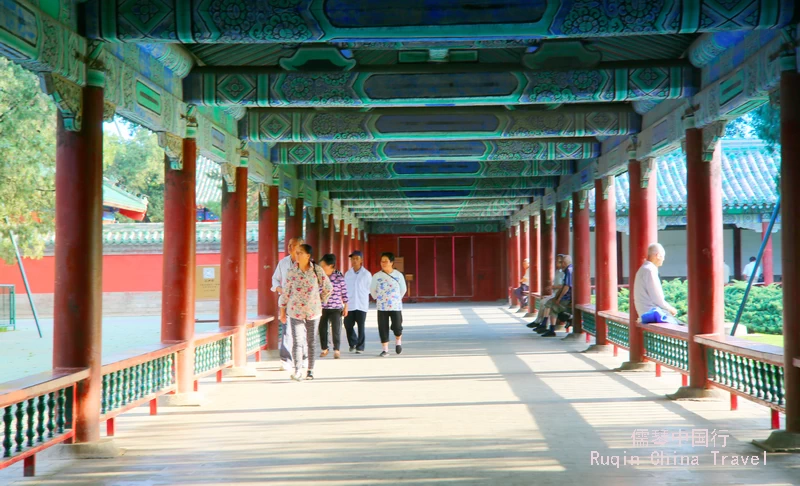
If you arrive early in the morning, you’ll witness locals practicing traditional activities like tai chi, flying kites, playing Chinese chess and cards, or even dancing. The sense of community here is palpable, and you might feel inspired to join in, or simply take a moment to appreciate the harmony of it all.
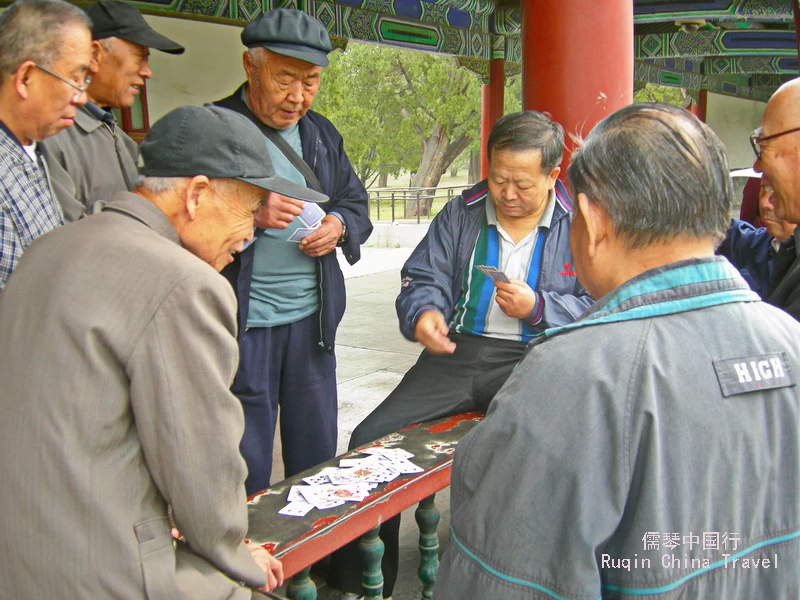
2) Marvel at the Hall of Prayer for Good Harvests
Continuing on your walk, the next stop is the Hall of Prayer for Good Harvests, the most iconic structure of the Temple of Heaven. This magnificent building is known for its unique, circular design and lack of nails in its construction. Built in 1420, the hall symbolizes the harmony between heaven and earth, which was central to the emperor’s role as the intermediary between the two realms.
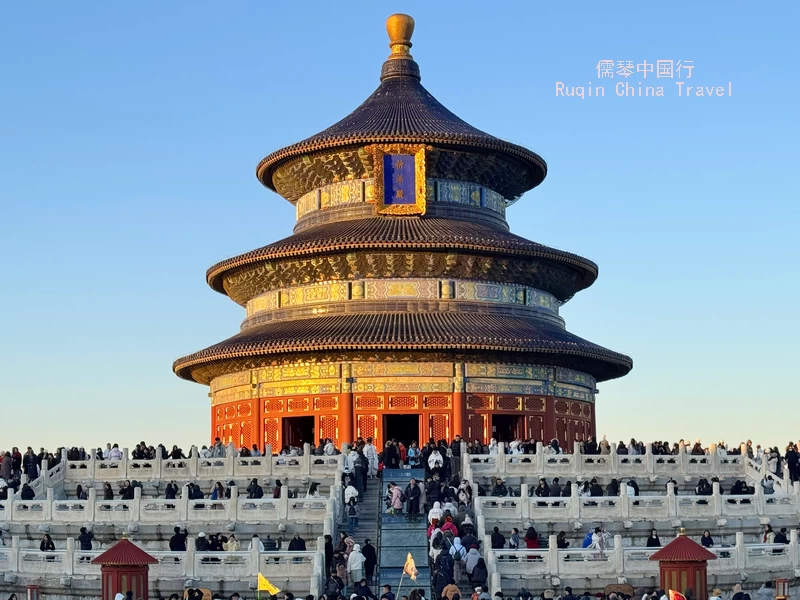
The hall’s grandeur and exquisite details make it a perfect spot for photos. Its blue-tiled roof, surrounded by red pillars and adorned with golden decorations, gleams under the sunlight. Take a moment to admire the structure, and let its symbolism sink in.
3) Walk through the Danbi Bridge
Then walk from the Hall of Prayer for Good Harvests towards the Echo Wall and Imperial Vault of Heaven along the Danbi Bridge. This walkway bridge forms the central axis of the Temple of Heaven, linking the Circular Mound Altar with the Hall of Prayer for Good Harvests.
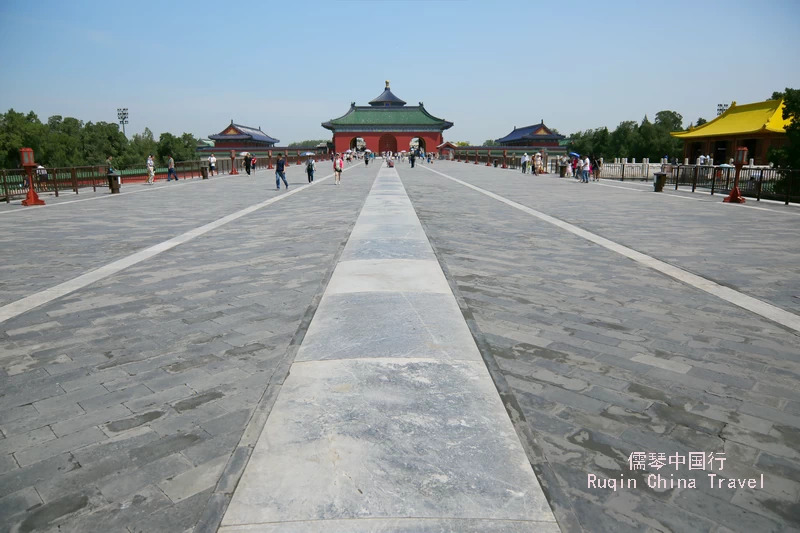
The Danbi Bridge is 360 meters long and connects the Circular Mound Altar with the Altar of Prayer for Grain. It is a grand avenue that rises 4 meters above the ground. In the middle of the bridge, there are east-west arched passages, which is why it’s called a “bridge.” It is the oldest “overpass” in Beijing.
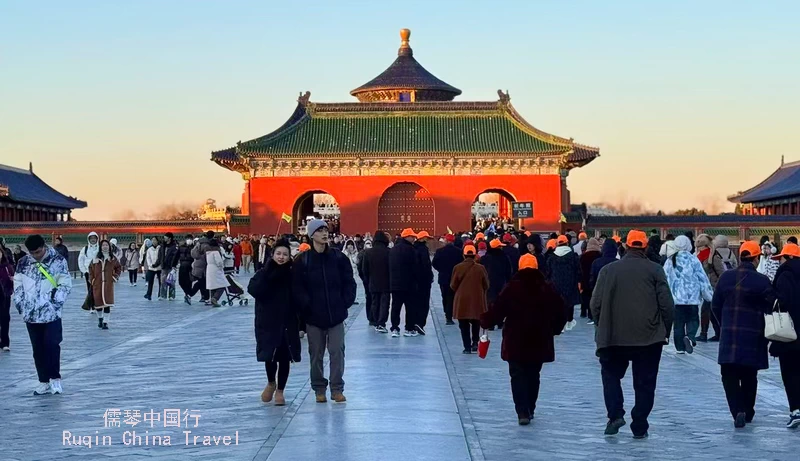
The bridge is 30 meters wide. The central stone path, known as the “Sacred Path,” was reserved for the exclusive use of the Emperor. The brick-paved road on the east side, called the “Imperial Road,” was for the Emperor’s use as well. The nobles and ministers who accompanied the Emperor could only walk on the “Royal Road” to the west. The division of these paths reflected a strict hierarchy.
The bridge slopes down from north to south. Walking northward, each step feels like you’re climbing higher, almost as if you are ascending to the heavens.
4) Discover the Echo Wall and Imperial Vault of Heaven
From the Hall of Prayer for Good Harvests, walk along the Danbi Bridge to continue your journey to the Imperial Vault of Heaven. This smaller, but equally impressive, building was used during imperial ceremonies.
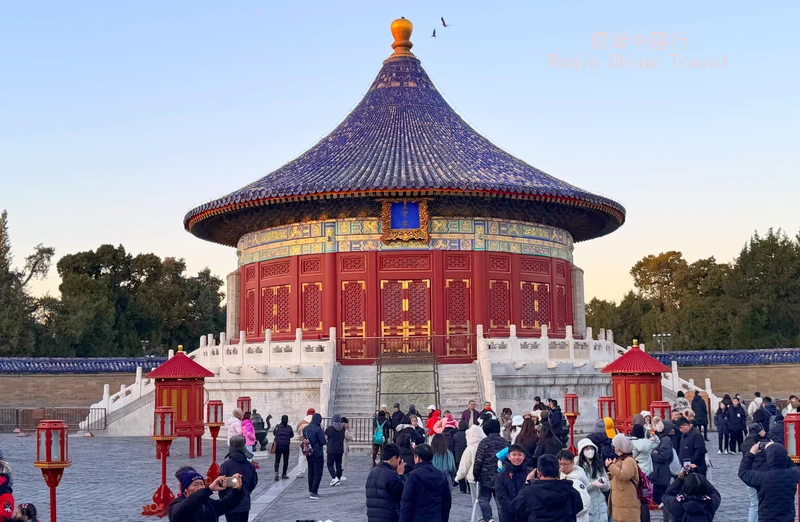
It is surrounded by a circular wall, known as the Echo Wall. Here, something magical happens: if you stand at one end of the wall and whisper, your voice will travel clearly to the other end. The acoustics are extraordinary, making it a fun and memorable spot to visit, especially with family or friends.
5) Visit the Circular Mound Altar
Next, make your way to the Circular Mound Altar, a sacred site where emperors once made sacrifices to the heavens. This raised marble platform is designed to amplify sound.
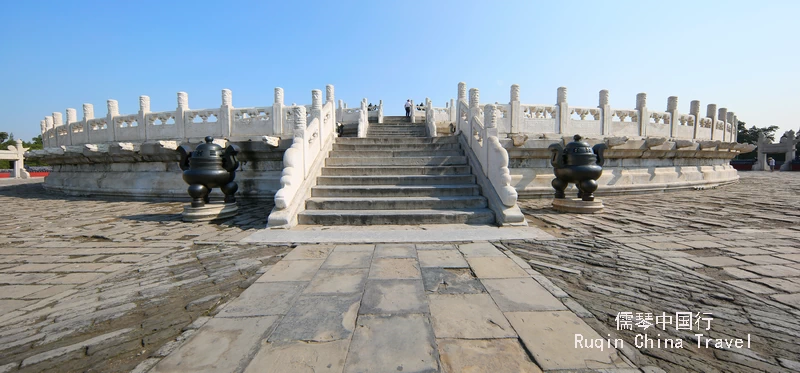
Stand in the very center, and you’ll notice that even the faintest whisper can be heard with startling clarity.
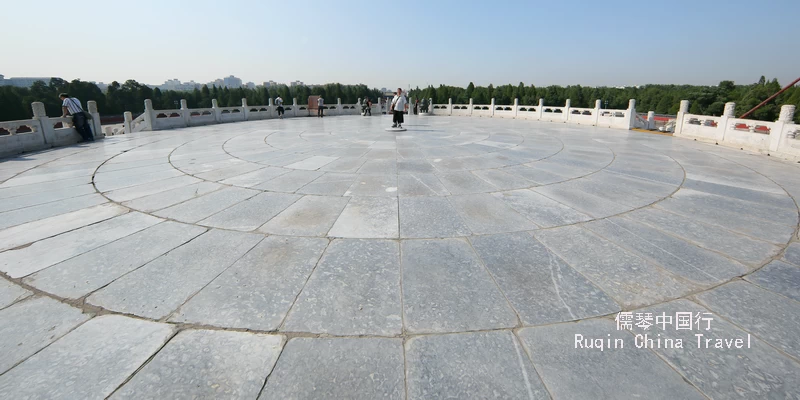
This was once used for the emperor’s ceremonial rituals, and now it’s an impressive spot for visitors to experience the power of acoustics in ancient Chinese architecture.
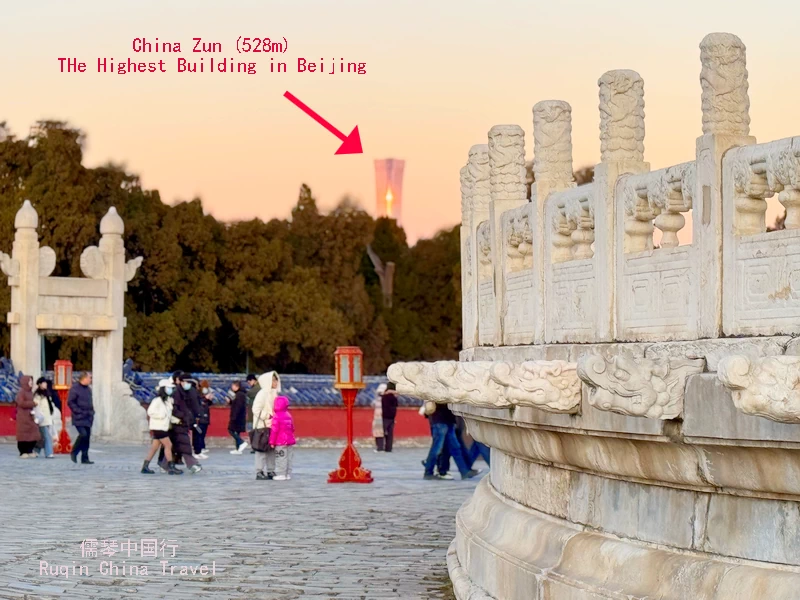
6) Relax in the Park’s Tranquil Gardens
After visiting the Circular Mound Altar, take a leisurely stroll back toward the East Gate. As you walk, enjoy the serenity of the park’s gardens. The lush greenery and quiet paths provide the perfect backdrop for reflection. Along the way, don’t miss the park’s ancient trees. The Temple of Heaven Park is home to a rich variety of tree species, including cypress, juniper, ginkgo, and pine. Many of these trees are over 600 years old, having witnessed the changing of dynasties and the passage of time.
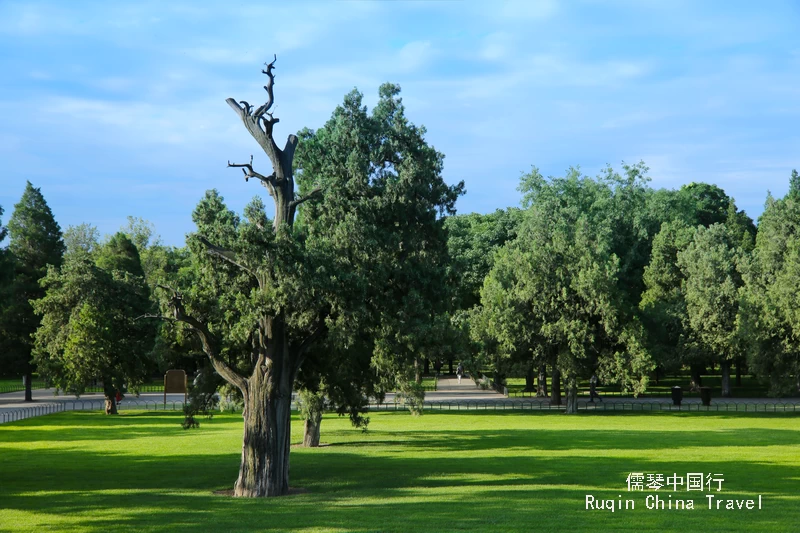
In total, there are 3,562 ancient trees within the park, with 1,147 classified as first-grade and 2,415 as second-grade. These trees are scattered around the main landmarks, including the Hall of Prayer for Good Harvests and the Echo Wall. They’ve silently stood guard for centuries, adding a sense of timelessness to the experience.
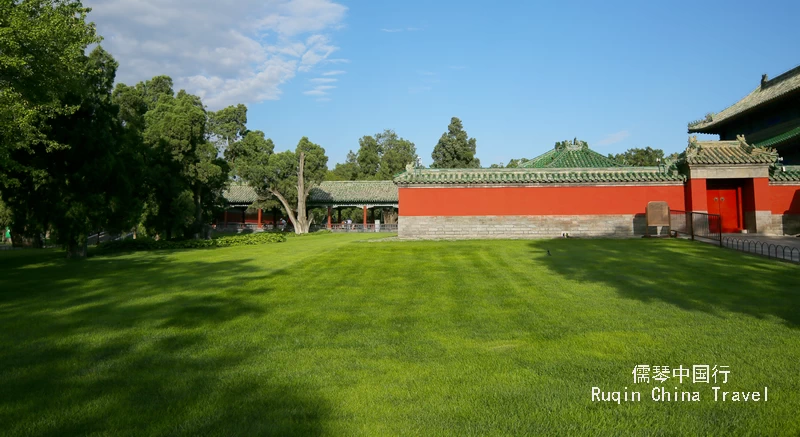
As Dr. Henry Kissinger once remarked during his visit, while the United States might be able to replicate the Temple of Heaven, it could never recreate these ancient trees. Their presence is a living testament to the enduring history of this sacred space.
Practical Information
The entire walking route can take around 2 to 3 hours, depending on how long you linger at each stop. It’s a relatively flat, easy walk that is suitable for visitors of all ages. Take your time to absorb the beauty of the gardens, marvel at the architecture, and enjoy the cultural atmosphere.
7) Complete Your Visit at the East Gate
Finish your tour back at the East Gate, where your walk began. This route will have taken you on a journey through time, from the architectural marvels of ancient China to the vibrant activities of the local people. Throughout your walk, take your time—there’s no need to rush. Whether you’re admiring the structures, joining the locals in their morning routines, or simply soaking in the tranquility of the park, the Temple of Heaven is best experienced at a leisurely pace.
Nearby Attractions and City Walk
After immersing yourself in the grandeur of the Temple of Heaven, why not continue exploring the city with a leisurely walk? Exit from the North Gate of the Temple of Heaven and head towards the nearby Caochang Hutongs (草厂).
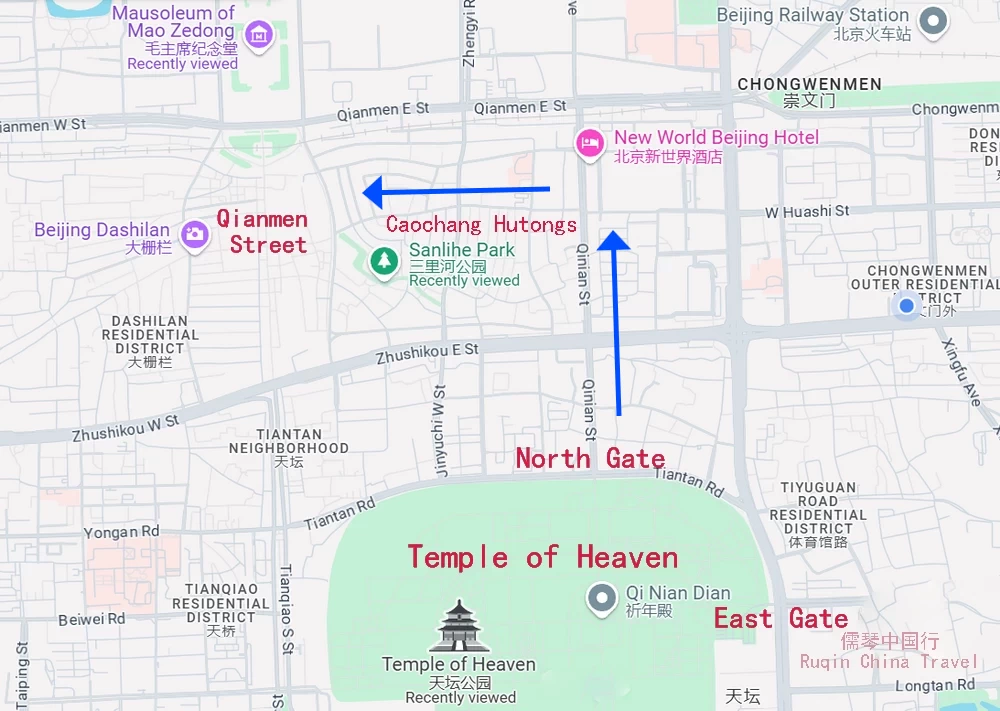
The Caochang Hutongs are a hidden gem, offering a rare glimpse into traditional Beijing life. Located near Qianmen, these narrow alleys have largely escaped the grip of commercialization, making them the perfect spot for those looking to experience the authentic charm of old Beijing.
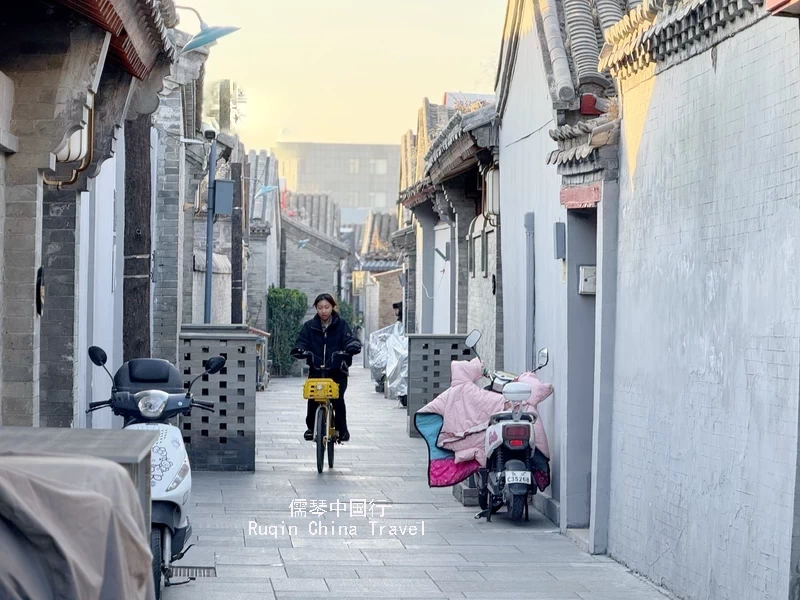
Wander through the maze of well-preserved lanes, where time seems to slow down. You’ll encounter ancient courtyard homes, small local shops, and Beijing’s unique blend of history and culture at every turn.
From here, take a short stroll to Sanlihe Park (三里河公园), a peaceful oasis that offers a welcome break from the bustling city. Unlike the more famous and crowded parks, Sanlihe Park is a serene escape.
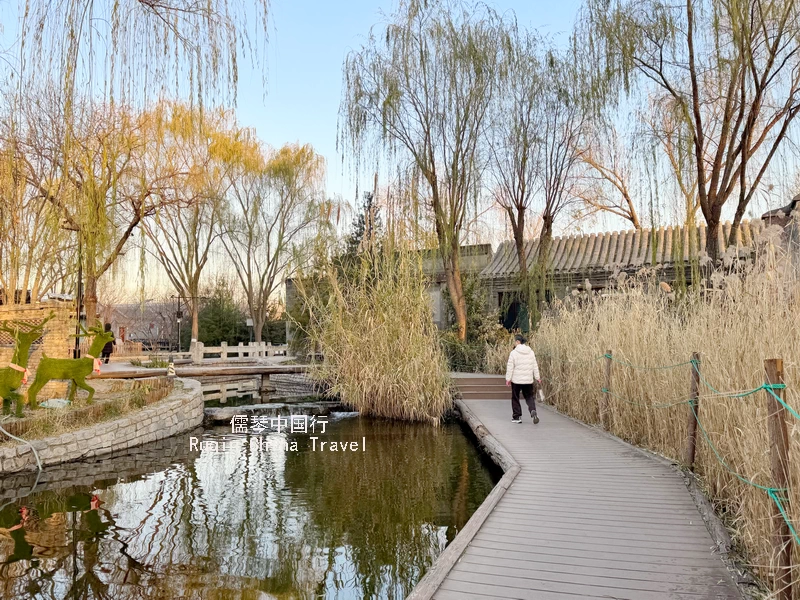
The park exudes the tranquil charm of Jiangnan water towns, with its meandering rivers, quiet pavilions, and lush greenery. It’s the perfect place to relax, unwind, and enjoy a slower pace of life, far from the usual tourist crowds.
Next, make your way to the nearby Qianmen Street, a lively blend of old and new. As you walk down the street, you’ll see modern cafes and retail shops nestled alongside ancient teahouses, traditional Chinese medicine stores, and street vendors selling local snacks.
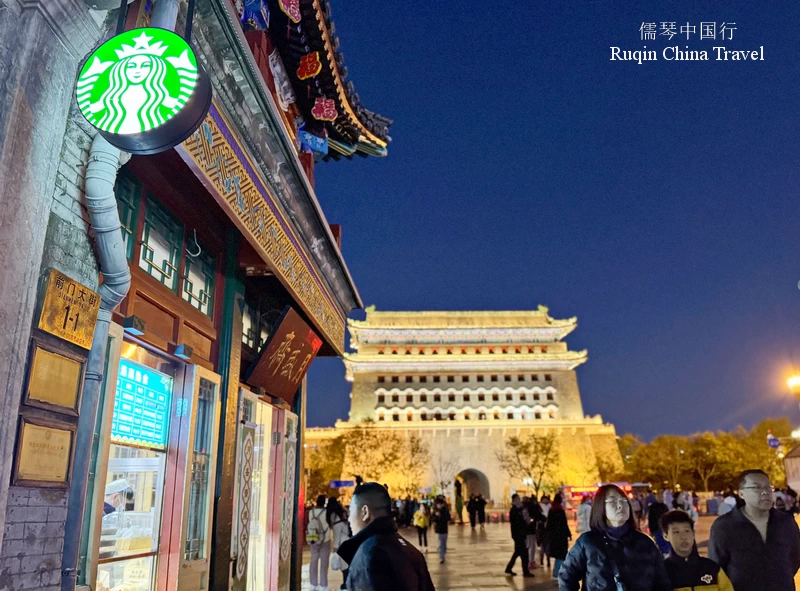
This fusion of contemporary and historic creates a vibrant atmosphere, capturing the essence of Beijing’s rich cultural heritage. It’s a great place to shop, snack, or simply soak in the unique ambiance of the city.
This city walk will take you through Beijing’s past and present, offering a deeper connection to the city’s heart and soul.
Now that you know how to visit the Temple of Heaven, you’re ready for an unforgettable experience in Beijing. From its fascinating history to its stunning architecture, the Temple of Heaven offers a deep dive into Chinese culture and traditions. With this guide in hand, you’ll know the best time to visit, what to see, and how to make the most of your day.
Whether you’re interested in its cultural significance or just want to enjoy the beauty of the site, the Temple of Heaven is a must-visit destination that should be on every traveler’s list.
More Beijing Travel Guides
Planning your Beijing tour? Our “Beijing Travel Guide“ section offers essential advice to help you navigate the city like a pro. From transportation tips and local customs to insider recommendations for hidden gems, these travel tips will ensure you have a smooth, enjoyable, and unforgettable experience in China’s vibrant capital. Let us guide you through the best practices for exploring Beijing with confidence!

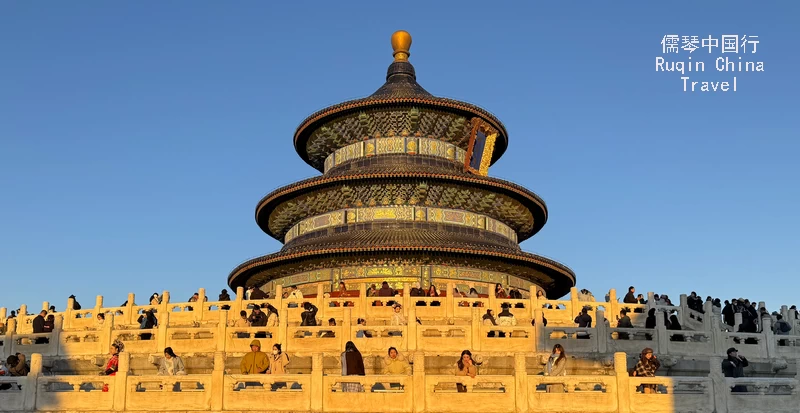
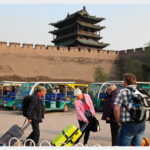

Hi , we are from Germany and we were told that we can use Beijing pass to buy the entrace tickets at the counter . We are travelling to Beijing in July peak season. Or do you advise to book in advance ? Or to buy there when we are visiting this temple.
Kindly advise . Thanks
Dear Hoon,
Thank you for reaching out to Ruqin China Travel!
Yes, you can use the Beijing Pass to purchase entrance tickets at the ticketing offices for various attractions including the Temple of Heaven.
For the Temple of Heaven, you can purchase tickets on-site without the need for reservations. The park is quite large, and there are no visitor limits, so you should have no trouble gaining entry. However, making reservations will save you time by avoiding long lines for ticket purchases during peak seasons.
However, for the Forbidden City, advance ticket reservations are required, as they do not offer on-site ticketing. For detailed information on how to reserve tickets in Beijing, I recommend reading my article: How to Reserve Tickets in Beijing.
I hope you have a wonderful time exploring Beijing! Should you have any further questions or need assistance, please don’t hesitate to reach out – we’re here to help!
Best regards,
Ruqin China Travel
Hi sorry, just checking is it possible to visit in the morning, and come back again in the evening with the same ticket or do I have to book separately?
Hi Alexis,
Thanks for reaching out! I just wanted to confirm that, unfortunately, you would need to purchase a new ticket for re-entry. The ticket is typically valid for one entry only, so it cannot be used for a second visit later in the day.
If you’re planning to go back in the evening, I’d recommend buying a separate ticket for the second visit. Let me know if you need help with the booking or if you have any other questions!
Hope this helps, and feel free to reach out if you need anything else!
Best regards,
Ruqin China TRavel